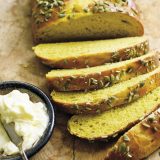While the idea of adding squash or pumpkin to baked goods has undeniable appeal—all that golden color and rich sweetness!—we’d mostly given up. The results too often are cloyingly sweet, sticky and stuffed with spices that cloud the flavor of the very vegetable they supposedly celebrate. So stumbling across a recipe for Kürbisbrot in Luisa Weiss’ book “Classic German Baking” was a refreshing surprise.
We loved this unusual bread for the orange tinge and gentle sweetness from the star ingredient: roasted butternut squash. Weiss’ assistant lived in Bremen, the town where Kürbisbrot originated, and they developed the recipe based on her recollections of it.
Traditionally, German bakers would have boiled squash for this recipe. But Weiss opted to roast her butternut squash (a New World squash now plentiful in Germany), ensuring a rich depth of flavor that trumps the tinny, one-note taste of the conventional canned stuff. And it lends a lovely hue. “The color is the most arresting thing about this bread, because it just turns this insane shade of orange—so happy and bright,” Weiss says. Better yet, the moisture-rich squash also creates a bread that keeps well and can be enjoyed for several days.
In Bremen, Kürbisbrot typically is eaten with savory toppings, such as ham, salami or liverwurst. (But, as we discovered, it also makes for an especially wonderful French toast.)
The first rise for this bread occurs in two stages: at room temperature for about one hour, then up to 24 hours in the refrigerator. The soft, sticky dough is easier to work with when cold, since the butter firms up when chilled. However, it’s important to be sure that the butter is at room temperature when initially added to the batter-like dough so it will more readily incorporate.
For our version, we added eggs for extra richness, resulting in a bread more in line with a brioche. We also reinforced the butternut flavor with two subtle enhancements: allspice and a touch of honey. According to Weiss, Kürbisbrot can be shaped as either a conventional round loaf or as a braided loaf. We decided to use a three-strand braid and layer on additional squash flavor and texture by scattering pumpkin seeds on top. The result: a sunny-looking loaf that shines throughout the cold-weather months.








